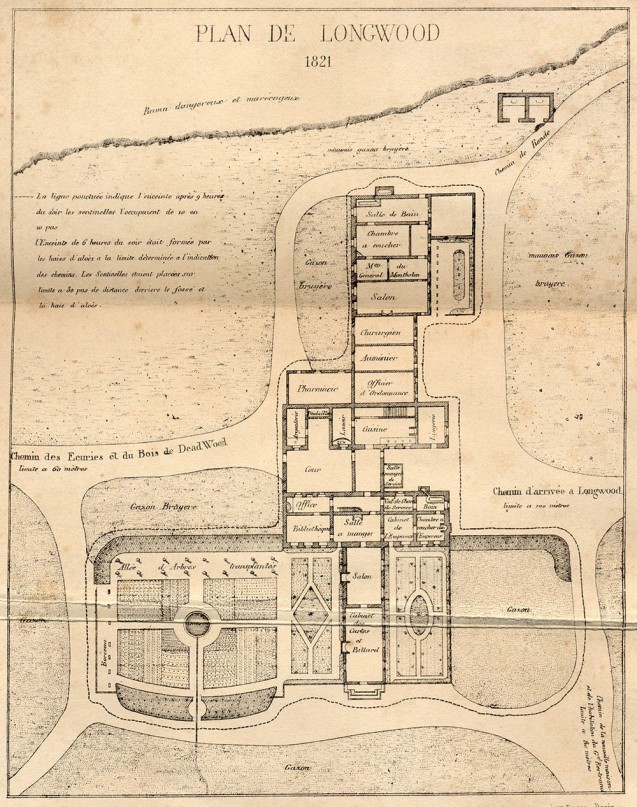Key to the plan of the house
The photographs below show the rooms as they are today, having been restored to as close as possible to their state in 1821.
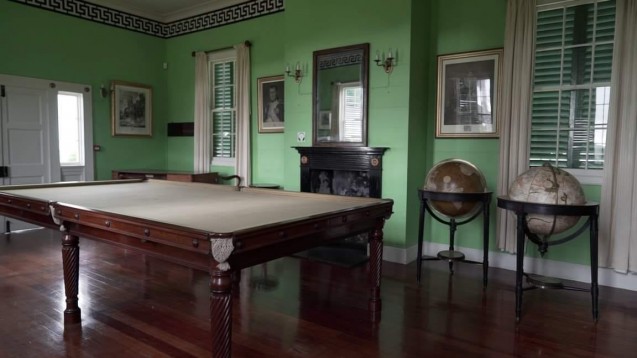 Cabinet des cartes et billard (Billiard or Map Room)
Cabinet des cartes et billard (Billiard or Map Room)
A large well-lit room which was added to the house just before Napoleon moved in. Napoleon used it as a dining room until July 1816, then it became the “Map Room” when the billiard table was delivered. This was where he dictated the story of his campaigns. It was also in this room that his autopsy took place on 6 may 1821.
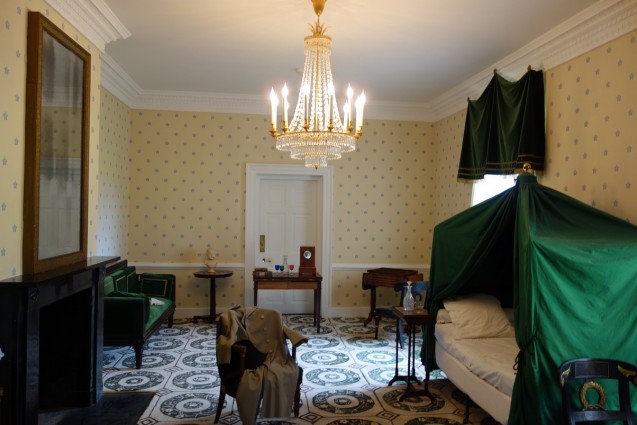 Salon (The Drawing Room or Parlour)
Salon (The Drawing Room or Parlour)
Beyond the Billiard Room was the Drawing Room. This is the room where Napoleon died at 5.49pm on 5 May 1821. There is a door at either end, 2 windows on one side and a marble fireplace on the opposite side. His camp bed was moved there from the small stuffy bedroom on 28 April, shortly before his death and placed between the two windows as depicted in the drawing by Marchand.
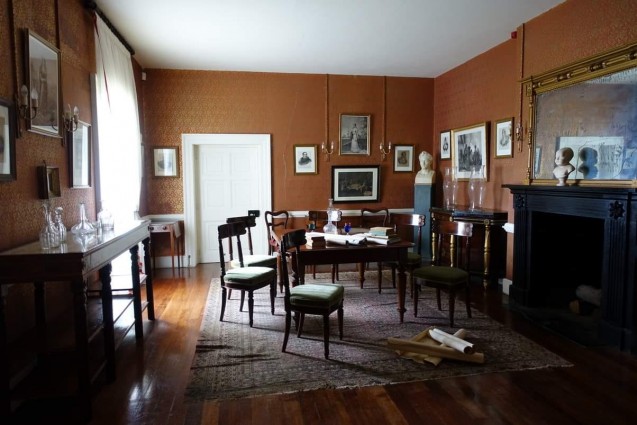 Salle à manger (Dining Room)
Salle à manger (Dining Room)
Beyond the Drawing Room was the Dining Room. The only source of light in this room was a French window giving onto a garden. Beyond the French window, a door led to the library. In the opposite direction, a facing door lead to Napoleon’s quarters. At first, this room was Napoleon’s map room and library. It became the Dining Room after the arrival and installation of the billiard table in the room previously used for dining. When the clerics, the Abbé Vignali and the chaplain Buonavita, arrived on 20 September 1819, a place was needed to say mass. The first mass was celebrated in the Drawing Room (3 October 1819) but the following month Napoleon decided that the Dining Room would be used for masses on Sundays.
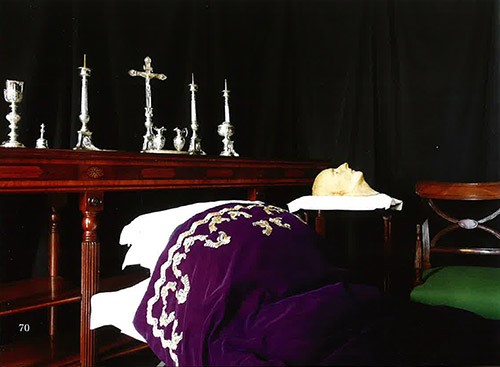 Cabinet de l’Empereur (The Emperor’s Study, used after Napoleon’s death as a Mortuary Chapel)
Cabinet de l’Empereur (The Emperor’s Study, used after Napoleon’s death as a Mortuary Chapel)
This small room, with no fireplace, was one of the least comfortable in the house, more like a cellar, according to Napoleon. The furnishings during the first years of the exile were spartan. This was where Napoleon sat for hours with Las Cases father and son around a work table, while books and notes were placed on planks on trestles. A camp bed stood opposite the window, where Napoleon sometimes took a nap or slept at night, alternating with that in the adjoining bedroom. It was in this room that Napoleon’s body was presented on the evening of 6 May after the autopsy and where visitors came to pay their last respects.
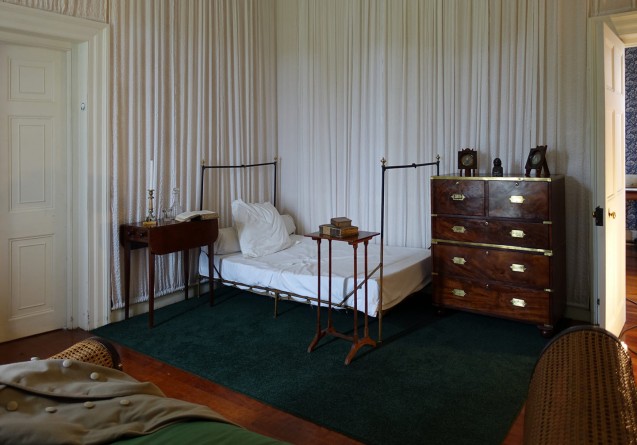 Chambre à coucher de l’Empereur (The Emperor’s Bedroom)
Chambre à coucher de l’Empereur (The Emperor’s Bedroom)
Napoleon did not always sleep here, he sometimes slept in his Study on one of his campbeds. Around the 26 April 1821, a bed was moved to the Drawing Room where he remained until he died on 6 May.
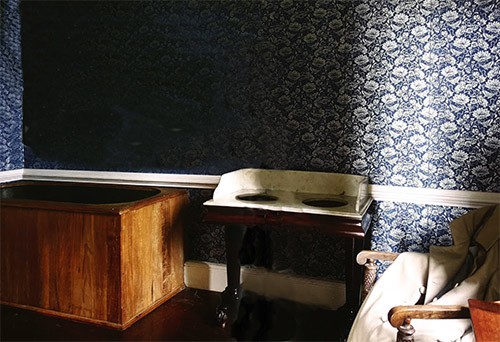 Salle de bain (The Emperor’s Bathroom)
Salle de bain (The Emperor’s Bathroom)
Napoleon spent many hours in his bath; it helped relieve his various ailments.
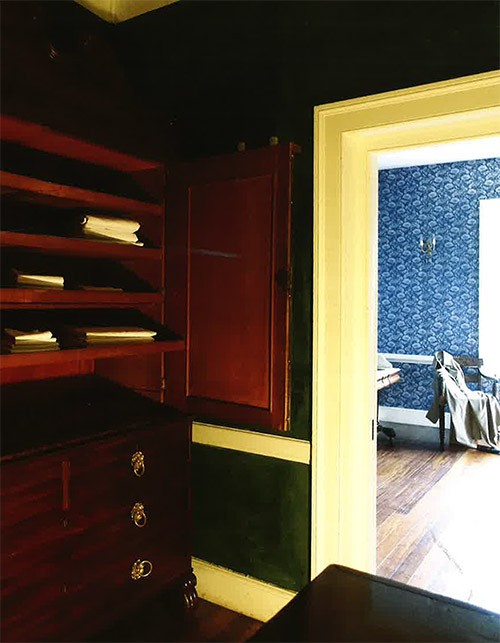 Valet de chambre de Service (Marchand’s Room)
Valet de chambre de Service (Marchand’s Room)
This room was where Napoleon’s linen was kept and where Marchand could sit in order to be close to his master during the night.
[Stairwell beyond the Dining Room]
This room was a crossroads leading to the other rooms, including a stairs to the attic where the servants Marchand, Novarraz and Ali lived. Marchand’s bedroom was situated directly above that of his master.
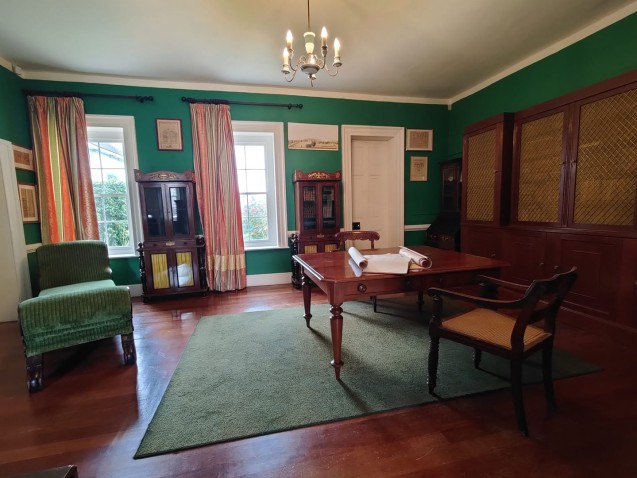 Bibliothèque (Library)
Bibliothèque (Library)
This damp room, beyond the dining room, was where the Montholons lived until their lodgings had been built in the extension to Longwood (July 1816). Then Napoleon decided to make it into a library.
In 1816, after Napoleon’s arrival at Longwood, several more rooms were added including:
Officier d’Ordonnance (Orderly Officer)
Room occupied by the Orderly Officer. At the time of Napoleon’s death, this was the British officer William Crokat (who kept in constant contact with Hudson Lowe on the state of the prisoner), and who would be given the job of carrying the news of Napoleon’s death to Europe.
Aumonier (Chaplain)
This room was occupied at the time of Napoleon’s death by the priest Abbé Vignali, who heard Napoleon’s confession in his final days and administered to him the last rites. He also led the funeral ceremony on 9 May.
Chirugien (Surgeon)
Occupied by Antommarchi, the surgeon who performed the autopsy on 6 May 1821.
Salon / Monsieur General du Montholon / Chambre à coucher / Salle de Bains (Drawing Room, General de Montholon, Bedroom, Bathroom)
These rooms were occupied by the Montholons from July 1816.
Text by Rebecca Young (April 2021)


